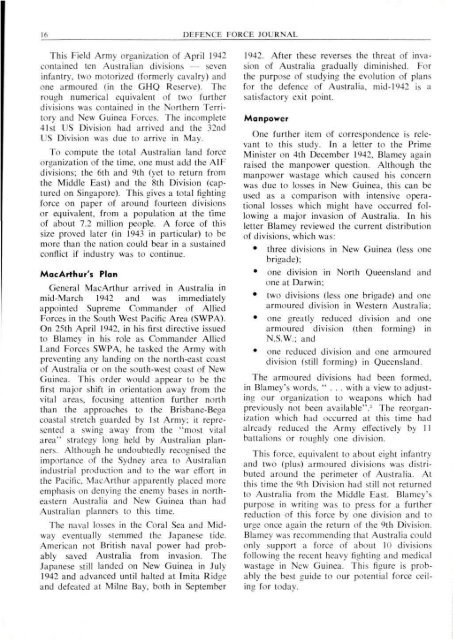ISSUE 1 : Nov/Dec - 1976 - Australian Defence Force Journal
ISSUE 1 : Nov/Dec - 1976 - Australian Defence Force Journal
ISSUE 1 : Nov/Dec - 1976 - Australian Defence Force Journal
You also want an ePaper? Increase the reach of your titles
YUMPU automatically turns print PDFs into web optimized ePapers that Google loves.
16 DEFENCE FORCE JOURNALThis Field Army organization of April 1942contained ten <strong>Australian</strong> divisions — seveninfantry, two motorized (formerly cavalry) andone armoured (in the (iHQ Reserve). Therough numerical equivalent of t\u> furtherdivisions was contained in the Northern Territoryand New Guinea <strong>Force</strong>s. The incomplete41st US Division had arrived and the 32ndUS Division was due to arrive in May.To compute the total <strong>Australian</strong> land forceorganization of the time, one must add the AIFdivisions; the 6th and 9th (yet to return fromthe Middle East) and the 8th Division (capturedon Singapore). This gives a total fightingforce on paper of around fourteen divisionsor equivalent, from a population at the timeof about 7.2 million people. A force of thissize proved later (in 1943 in particular) to bemore than the nation could bear in a sustainedconflict if industry was to continue.MacArthur's PlanGeneral MacArthur arrived in Australia inmid-March 1942 and was immediatelyappointed Supreme Commander of Allied<strong>Force</strong>s in the South West Pacific Area (SWPA).On 25th April 1942, in his first directive issuedto Blarney in his role as Commander AlliedI and <strong>Force</strong>s SWPA, he tasked the Army withpreventing any landing on the north-east coastof Australia or on the south-west coast of NewGuinea. This order would appear to be thefirst major shift in orientation away from thevital areas, focusing attention further norththan the approaches to the Brisbane-Begacoastal stretch guarded by 1st Army; it representeda swing away from the "most vitalarea" strategy long held by <strong>Australian</strong> planners.Although he undoubtedly recognised theimportance of the Sydney area to <strong>Australian</strong>industrial production and to the war effort inthe Pacific, MacArthur apparently placed moreemphasis on denying the enemy bases in northeasternAustralia and New Guinea than had<strong>Australian</strong> planners to this time.The naval losses in the Coral Sea and Midwayeventually stemmed the Japanese tide.American not British naval power had probablysaved Australia from invasion. TheJapanese still landed on New Guinea in July1942 and advanced until halted at Imita Ridgeand defeated at Milne Bay, both in September1942. After these reverses the threat of invasionof Australia gradually diminished. Forthe purpose of studying the evolution of plansfor the defence of Australia, mid-1^42 is asatisfactory exit point.ManpowerOne further item of correspondence is relevantto this studs. In a letter to the PrimeMinister on 4th <strong>Dec</strong>ember 1942, Blarney againraised the manpower question. Although themanpower wastage which caused his concernwas due to losses in New Guinea, this can beused as a comparison with intensive operationallosses which might have occurred followinga major invasion of Australia. In hisletter Blarney reviewed the current distributionof divisions, which was:• three divisions in New Guinea (less onebrigade);• one division in North Queensland andone at Darwin;• two divisions (less one brigade) and onearmoured division in Western Australia;• one greatly reduced division and onearmoured division (then forming) inN.S.W.; and• one reduced division and one armoureddivision (still forming) in Queensland.The armoured divisions had been formed,in Blarney's words, "... with a view to adjustingour organization to weapons which hadpreviously not been available".- The reorganizationwhich had occurred at this time hadalready reduced the Army effectively by 11battalions or roughly one division.This force, equivalent to about eight infantryand two (plus) armoured divisions was distributedaround the perimeter of Australia. Atthis time the 9th Division had still not returnedto Australia from the Middle East. Blarney'spurpose in writing was to press for a furtherreduction of this force by one division and tourge once again the return of the 9th Division.Blarney was recommending that Australia couldonly support a force of about 10 divisionsfollowing the recent heavy fighting and medicalwastage in New Guinea. This figure is probablythe best guide to our potential force ceilingfor today.
















